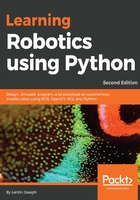
上QQ阅读APP看书,第一时间看更新
Introducing Gazebo
Gazebo is a free and open source robot simulator in which we can test our own algorithms, design robots, and test robots in different simulated environments. Gazebo can accurately and efficiently simulate complex robots in indoor and outdoor environments. Gazebo is built with a physics engine with which we can create high-quality graphics and rendering.
The features of Gazebo are as follows:
- Dynamic simulation: Gazebo can simulate the dynamics of a robot using physics engines such as Open Dynamics Engine (ODE). (http://opende.sourceforge.net/), Bullet (http://bulletphysics.org/wordpress/), Simbody (https://simtk.org/home/simbody/), and DART (http://dartsim.github.io/).
- Advanced 3D graphics: Gazebo provides high-quality rendering, lighting, shadows, and texturing using the OGRE framework (http://www.ogre3d.org/).
- Sensor support: Gazebo supports a wide range of sensors, including laser range finders, Kinect-style sensors, 2D/3D cameras, and so on. We can also use it to simulate noise to test audio sensors.
- Plugins: We can develop custom plugins for the robot, sensors, and environmental controls. Plugins can access Gazebo's API.
- Robot models: Gazebo provides models for popular robots, such as PR2, Pioneer 2 DX, iRobot Create, and TurtleBot. We can also build custom models of robots.
- TCP/IP transport: We can run simulations on a remote machine and a Gazebo interface through a socket-based message-passing service.
- Cloud simulation: We can run simulations on the cloud server using the CloudSim framework (http://cloudsim.io/).
- Command-line tools: Extensive command-line tools are used to check and log simulations.